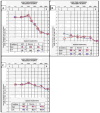Age-related hearing loss: is it a preventable condition?
- PMID: 19735708
- PMCID: PMC2868117
- DOI: 10.1016/j.heares.2009.09.001
Age-related hearing loss: is it a preventable condition?
Abstract
Numerous techniques have been tested to attempt to prevent the onset or progression of age-related hearing loss (ARHL): raising the animals in an augmented acoustic environment (used successfully in mouse and rat models), enhancing the antioxidant defenses with exogenous antioxidant treatments (used with mixed results in mouse and rat models), raising the animals with a calorie restricted diet (used successfully in mouse and rat models), restoring lost endocochlear potential voltage with exogenous electrical stimulation (used successfully in the Mongolian gerbil model), and hypothetical enhancement of outer hair cell electromotility with salicylate therapy. Studies of human ARHL have revealed a set of unique hearing loss configurations with unique underlying pathologies. Animal research has developed models for the different forms of age-related peripheral pathology. Using the animal models, different techniques for prevention of ARHL have been developed and tested. The current review discusses ARHL patterns in humans and animal models, followed by discussions of the different prevention techniques.
Copyright 2009 Elsevier B.V. All rights reserved.
Figures






References
-
- Aggarwal BB, Takada Y, Oommen OV. From chemoprevention to chemotherapy: common targets and common goals. Expert Opin Investig Drugs. 2004;13:1327–38. - PubMed
-
- Barger JL, Kayo T, Vann JM, Arias EB, Wang J, Hacker TA, Wang Y, Raederstorff D, Morrow JD, Leeuwenburgh C, Allison DB, Saupe KW, Cartee GD, Weindruch R, Prolla TA. A low dose of dietary resveratrol partially mimics caloric restriction and retards aging parameters in mice. PLoS ONE. 2008;3:e2264. - PMC - PubMed
-
- Baur JA, Pearson KJ, Price NL, Jamieson HA, Lerin C, Kalra A, Prabhu VV, Allard JS, Lopez-Lluch G, Lewis K, Pistell PJ, Poosala S, Becker KG, Boss O, Gwinn D, Wang M, Ramaswamy S, Fishbein KW, Spencer RG, Lakatta EG, Le Couteur D, Shaw RJ, Navas P, Puigserver P, Ingram DK, de Cabo R, Sinclair DA. Resveratrol improves health and survival of mice on a high-calorie diet. Nature. 2006;444:337–42. - PMC - PubMed
Publication types
MeSH terms
Substances
Grants and funding
LinkOut - more resources
Full Text Sources
Other Literature Sources
Medical

